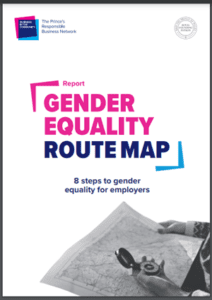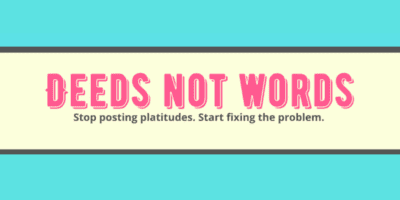Katy Neep is the gender equality campaign director at Business in the Community, the charity that works to accelerate change across all areas of responsible business from climate change to inclusive employment. Katy studied history at Newcastle University, initially embarking on a marketing career at Bettys and Taylors in Harrogate, before moving across to working in responsible business in the charity space. She first joined Business in the Community in 2014 as head of campaigns for education and skills.

“To close the pay gap we must look at barriers related to intersectionality – women are not one homogenous group.”
From afternoon tea to equality
Education wise I went to secondary school in York at a school named after Joseph Rowntree providing an early insight into what responsible employers could look like. Post university, with a brief interlude in marketing for Bettys and Taylors I quickly found myself in the world of responsible business working on campaigns across education, employment and currently gender equality in the workplace.
Creating a truly equal working world
Business in the Community exists fundamentally to make work, work for all people and the planet. We work through our membership of employers to accelerate change across all areas of responsible business from climate change to inclusive employment.
I am currently the gender equality campaign director at Business in the Community. This means I have the pleasure and privilege of creating and championing our campaign focus, calls to action and outputs. We exist as a campaign to create a truly equal working world where everyone, regardless of gender, can flourish – focussing on how we can enact change within the workplace on the inequality indicators of pay, power, job security and harassment and discrimination.
In a nutshell, my role is to encourage and enable employers to accelerate change across policies, programmes and, importantly, workplace culture.
Keeping up momentum
When mandatory Gender Pay Gap reporting was suspended during the pandemic, we saw a huge downturn in the number of employers who published their pay gap. BITC published analysis in May 2020 that revealed less than half of eligible employers chose to publish their Gender Pay Gaps when enforcement was suspended due to the pandemic (5,081 in 2020 vs. 10,828 in 2019).
As mandatory reporting has come back into place we have seen through BITC’s Gender Pay Gap Reporting Dashboard a return in line with pre-pandemic levels, with 10,491 employers publishing their gap. This is clearly positive news, but we would like to see more employers publishing their action plans alongside their gaps – making a public commitment to the change they are going to undertake to close it because it is this that is going to make change not simply reporting the figures.
BITC, championed by our race director, Sandra Kerr also wants the government to introduce mandatory ethnicity pay gap reporting. Currently, there are just over 888,000 employees who are employed by companies that publish their ethnicity pay gap which is less than 3% of the entire UK workforce. BITC research found that without government action, it will take until 2075 for companies currently capturing ethnicity data to publish it.
To close the pay gap for all women we must look at the barriers related to intersectionality – women are not one homogenous group.
Gender Equality Route Map

Whilst there is a range of reasons why the gender pay gap remains the key contributor is the impact of balancing work and care. Last year we launched our Who Cares research conducted by Ipsos which found that nearly six out of 10 women (58%) say caring responsibilities have stopped them from applying for promotion or a new job, and one in five (19%) have left a job because it was too hard to balance work and care. The research also found that one in three (32%) Black, Asian, Mixed Race and other ethnically diverse people have left or considered leaving a job due to a lack of flexibility compared with one in five (21%) white people.
To turn the tide on these statistics and reduce their pay gap we call on employers to deliver equity in their caring policies, specifically, we ask that they ladder up to implementing equal parental leave. Unequal parental leave can contribute up to 70% of an organisation’s gender pay gap and we support employers through our recently launched toolkit, calculator and peer support to make this change.
Central to our approach at BITC is the balance of calling on employers to make a change and providing them with the tools to enact that change. Our Advisory Team enable the latter, providing support including policy reviews and our Navigating Pay Gap Reporting Workshop, which allows organisations to model their future pay gaps and how this can be addressed through different interventions.
Pay transparency and removal of pay history are key
We see employers embedding a range of activities to try and close their gender pay gap. From setting measurable goals and action plans to increased monitoring and transparency of pay across the organisation via real-time dashboards.
Aviva was one of our Times Top 50 listed companies last year, conducting annual equal/gender pay audits and last year they launched their first ethnicity pay gap report. This has led to a focus on development programmes for women leaders. They also provide clear visibility of salary ranges as part of their salary negotiations.
Transparency of pay and the removal of pay history is something that we see a number of leading employers doing. This is pivotal if we are to close the gap and simply perpetuate the current situation.
The missing piece in the UK
Within its Bridging the Gap report, the Global Institute for Women’s Leadership highlights what works in terms of getting employers to take action through legislation. What is clear is that success in terms of tying reporting to action requires accountability and transparency, published action plans, the ability to issue sanctions for noncompliance and taking an intersectional approach.
The missing piece in UK legislation is that whilst reporting the gap is mandatory, reporting and monitoring the action needed to close that gap is not. So, whilst useful to have the data it is not making the change at the pace and scale it could do if there was also a follow-up around the ‘what next/so what?’ element.
Accessible ways we can all effect change together

One of the ways that we create change in the workplace is through employee voice and activation. If you work for an employer who has published their pay gap but no action plan as to how to address pay gaps within their organisation – ask to see it or work with your employee networks to get sight of it – transparency is key.
Throughout this piece I have mentioned toolkits and resources that you can access – please do so. Share across your networks and use within your own organisations. The more organisations we can engage on the importance of closing the pay gap the better.
Whilst BITC’s core membership is predominantly larger employers, all of the items I have talked about in this piece are accessible to smaller organisations.
Ensuring that best-in-class policies do not simply stay on the virtual shelf
It feels that there is a bit of a head of steam around the link between economic growth and supporting women to gain and sustain good work. With legislation coming down the pipe on flexible working and childcare firmly at the heart of the recent budget (even if the practice does not match the theory) we have an opportunity to truly make the change we know we need to see.
There can be no more excuses; the solutions are already well-evidenced and practised by many employers. I am looking forward to continuing to focus on flexible work in the year ahead, understanding how we create the cultures we need to ensure that best-in-class policies do not simply stay on the virtual shelf.





